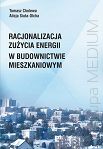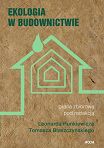Low energy and passive buildings ebook PDF
- Dodaj recenzję:
- Kod: 3839
- Producent: Grupa Medium
- Autor: Magdalena Grudzińska, Anna Ostańska, Anna Życzyńska
-
-
Najniższa cena 30 dni przed zmianą: 45,00 zł brutto
- szt.
- Cena netto: 47,62 zł 50,00 zł

Low energy and passive buildings
ebook PDF
rok wydania: 2017, wydanie pierwsze
format: PDF
zabezpieczenie: znak wodny
liczba plików do pobrania: 1 (PDF)
rozmiar pliku do pobrania: 4,49 MB
ISBN: 978-83-64094-58-3
Preface
Cutting down the use of non-renewable fuels and CO2 emission are among the key problems encountered by Poland and European Union, and the building sector together with energy-related industry are the main power consumers and contaminants producers. According to the Directive 2010/31/EU of the European Parliament, energy consumption for heating of buildings is responsible for 40% of the total primary energy use and 36% of CO2 emission in EU.
By 31st December 2020, all newly-erected buildings in Poland are to be nearly zero-energy ones. Making it possible requires introduction of national regulations on thermal protection levels and primary energy use in new constructions. At the same time, it is necessary to increase awareness of energy-related issues in buildings’ design and operation among society.
This book aims at presenting compact knowledge of low energy buildings. The issues discussed include, among others:
• architectural elements of energy-efficient houses, such as location shape and functional layout
• construction of opaque and glazed partitions, diminishing heat losses and enabling the effective use of solar energy
• construction of envelope joints minimizing thermal bridges
• implementation of design principles in practice, presented by examples of single-family buildings, multi-family housing estate and public utility buildings
• energy-efficient technical systems using renewable energy sources.
The content of the book may be important to all of the people taking part in building processes, especially designers and contractors. The publication is also addressed to students and individual investors, wanting to increase their knowledge about low energy buildings and their components.
Contents
Preface / 7
List of symbols and abbreviations / 8
1. Introduction / 11
1.1. Main energy sources / 11
1.2. Energy use in construction sector and buildings / 16
1.3. Low-energy buildings and their characteristics / 18
2. Architectural elements of low-energy houses / 22
2.1. External environment / 22
2.1.1. Climatic zone / 22
2.1.2. Landform features / 23
2.2. Location of the building within the plot / 24
2.3. Shape of the building / 25
2.3.1. Shape factor / 25
2.3.2. Shaping the block of the building / 26
2.4. Functional layout / 27
3. Opaque partitions in low-energy houses / 28
3.1. Requirements for thermal insulation / 28
3.2. Construction of opaque partitions / 31
3.2.1. External partitions / 31
3.2.2. Internal partitions / 36
3.3. Thermal bridges / 36
3.3.1. Elements reducing linear thermal bridges / 38
4. Glazed partitions in low-energy houses / 42
4.1. Requirements for thermal insulation / 42
4.2. Window frames / 43
4.3. Insulated glass units / 45
4.4. Edge spacers / 48
4.5. Window installation / 48
5. Airtightness of the building envelope / 50
6. Possibilities of using solar energy in buildings / 52
6.1. Elements and types of passive systems / 53
6.1.1. System of direct gains / 55
6.1.2. Systems of indirect gains / 56
7. Practical principles of passive houses design / 65
7.1. The main principles of passive houses design / 65
7.2. Design guidelines of passive houses design / 66
8. Examples of good practice in design and construction of passive houses / 68
8.1. Passive single-family building in the style of an old Polish manor house / 69
8.2. Passive single-family building with a masonry construction / 72
8.3. Rebuilding, extension, superstructure and thermal modernization of a single-family building with a brick construction for a passive house / 75
8.4. Housing estate of the passive multi-family houses / 78
8.4.1. Origin, purpose and costs / 78
8.4.2. Technical solutions / 80
8.5. Passive public utility buildings / 81
8.5.1. Passive sports hall / 81
8.5.2. Passive sacral building / 83
9. Ventilation, heating and hot water preparation in low-energy and passive houses / 86
9.1. Indicators of annual demand for final energy (EK) and primary energy (EP) / 86
9.2. Installation systems that use solar energy for hot water preparation and heating / 89
9.2.1. Types of solar collectors / 89
9.2.2. The use of solar collectors for hot water preparation and heating / 92
9.3 Ventilation with heat recovery / 93
9.4 Heat pumps / 95
9.5. Photovoltaic cells / 97
9.6. General technical requirements for ventilation, heating systems and hot
water preparation / 99
9.6.1. Ventilation / 99
9.6.2. Heating installation / 100
9.6.3. Hot water system / 101
10. Calculation of heat demand / 103
10.1. Internal and external conditions / 103
10.2. The annual energy need for heating / 104
10.2.1. Heat losses by transmission / 105
10.2.2. Heat losses by ventilation / 106
10.3. Heat gains / 107
10.3.1. Internal heat gains / 107
10.3.2. Heat gains from solar radiation / 107
10.4. Dynamic parameters / 108
The authorship of the chapters is as follows:
M. Grudzińska – chapters 1 to 6, 10
A. Ostańska – chapters 7, 8
A. Życzyńska – chapter 9.
Dr inż. Magdalena Grudzińska
Ukończyła Wydział Inżynierii Budowlanej i Sanitarnej Politechniki Lubelskiej. W 2004 roku obroniła pracę doktorską na temat przegród kolektorowych z izolacją transparentną. Pracuje jako adiunkt w Katedrze Budownictwa Ogólnego na Wydziale Budownictwa i Architektury Politechniki Lubelskiej. Naukowo zajmuje się budynkami o obniżonym zapotrzebowaniu na energię i możliwościami pasywnego pozyskiwania energii słonecznej. Jest autorką 2 monografii i ponad 50 artykułów z zakresu budownictwa ogólnego, fizyki budowli i budownictwa niskoenergetycznego.
Dr inż. Anna Ostańska
Absolwentka Wydziału Inżynierii Budowlanej i Sanitarnej Politechniki Lubelskiej. W 2008 roku obroniła pracę doktorską na temat problemów modernizacji i rewitalizacji zespołów prefabrykowanej zabudowy mieszkaniowej na Wydziale Architektury Politechniki Wrocławskiej. Pracuje w Politechnice Lubelskiej na Wydziale Budownictwa i Architektury, obecnie w Katedrze Architektury, Urbanistyki i Planowania Przestrzennego, jako adiunkt. Naukowo zajmuje się poprawą jakości życia w budynkach prefabrykowanych opartą na autorskich cyklicznych interdyscyplinarnych badaniach społecznych (CIBA), oceną stanu technicznego i możliwych rewitalizacyjnych działań naprawczych ukierunkowanych na remonty, energooszczędność i ekologię. Jest autorką ponad 60 publikacji naukowych, w tym 3 monografii.
Dr inż. Anna Życzyńska
Pracuje w Politechnice Lubelskiej na Wydziale Budownictwa i Architektury. Zajmuje się naukami technicznymi z zakresu inżynierii środowiska. W obszarze jej zainteresowań naukowych znajdują się auditing energetyczny, gospodarowanie energią w budynku, termomodernizacja budynków, instalacje sanitarne, a także fizyka budowli. Często współpracowała z jednostkami samorządów terytorialnych, spółdzielniami mieszkaniowymi i innymi podmiotami z zewnętrznego otoczenia gospodarczego w zakresie prowadzenia doradztwa energetycznego, szkoleń oraz kursów specjalistycznych związanych z termomodernizacją, auditingiem energetycznym i charakterystyką energetyczną budynku. Posiada uprawnienia zawodowe audytora energetycznego, pełne do projektowania w zakresie instalacji i sieci sanitarnych.



